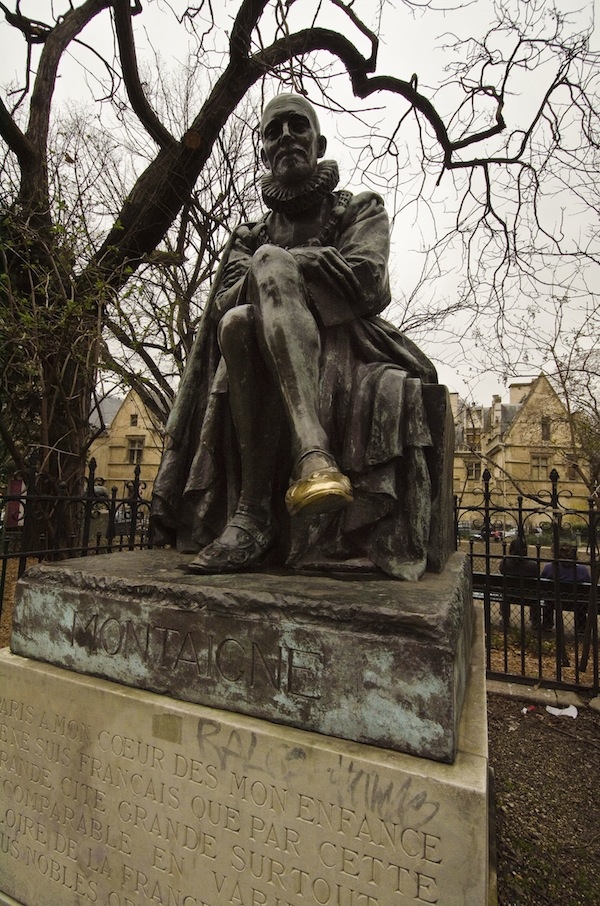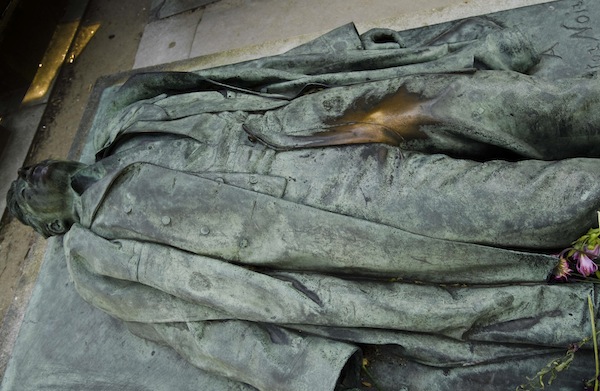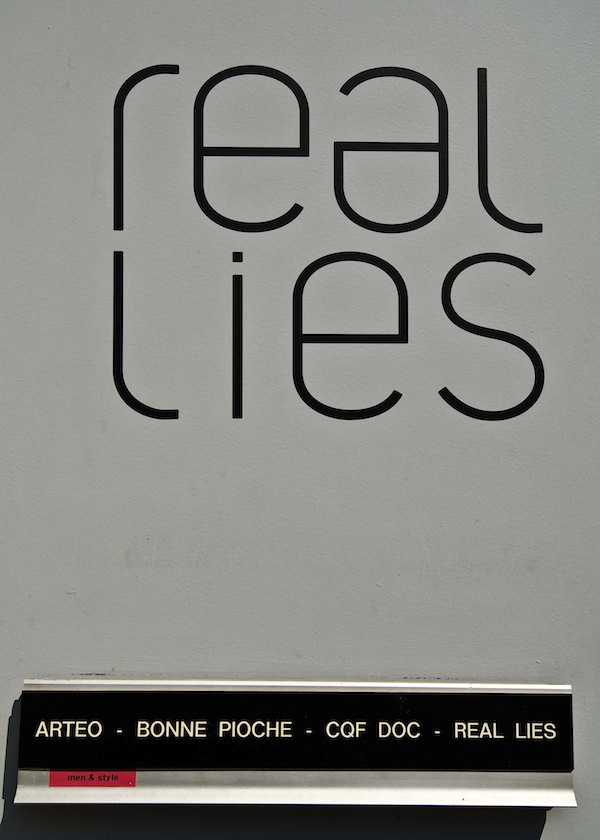Just around the corner from us, and a few blocks west down rue des Écoles (street of the schools), is a tiny public square, named for Paul Panlevé, a mathematician and physicist, and not terribly competent French prime minister, circa World War I.
The square is probably more famous for the life-sized statue of Michel de Montaigne, father of the essay, a rich and distinctive prose form which still enchants writers (and readers) to this day. The statue of a seated, pensive Montaigne faces the front door of the Sorbonne, across the street, probably the most famous of French colleges, part of the University of Paris since 1257. It was the Sorbonne and other schools of the early Middle Ages that taught in Latin until the French Revolution, giving our neighborhood its most common appellation, the Latin Quarter.
If you look closely at the Montaigne sculpture, you'll see that his connection to French education continues to this day, if not in the halls of the Sorbonne (we jest, of course he is taught there), at least in urban legend. The statue's bronze foot is worn to a golden patina because students believe it's good luck to rub his foot before an exam.
Are urban legends mere falsehoods, or real lies?
Who can say? But this tradition has crossed the Atlantic, too, at least as far as the College of William & Mary in Williamsburg, Virginia, the second college in the American colonies. There, students rub the shoe on the marble statue of the bewigged Lord Botetourt, the former English governor, also in the hope of good luck going into a big test or final.
And there's yet another French statue-rubbing tradition, this one in Paris' 20th arrondissement.
A couple of miles northeast of us (a brisk Sunday walk) is Père-Lachaise, Paris' largest cemetery, whose most famous tenant is probably the American singer Jim Morrison. It also houses (among others) Gertrude Stein, Oscar Wilde, Alice B. Toklas, Colette, Yves Montand and Simone Signoret (side by side), Sarah Bernhardt, Isadora Duncan, Edith Piaf, Stéphane Grappelli, Guillaume Apollinaire, Honoré de Balzac, Eugene Delacroix, Gustave Doré, Paul Eluard, Max Ernst, etc., etc.
And the writer Victor Noir.
Who?
To make a long story short, Noir (real name Yvan Salmon) was in 1869 a Paris journalist for a Corsican-language newspaper which, by insulting the long-dead Napoleon I, drew for its editor a challenge for a duel from the late emperor's grand-nephew, Prince Pierre Bonaparte, cousin of the then-ruling Emperor Napoleon III. The editor sent Noir and a buddy (both armed) to the prince's house in January, 1870, to work out the duel's terms, but, rather than acting as seconds (a sort of best man, or groomsmen at a duel) they mixed it up verbally with the prince, who, offended at the lack of proper custom, slapped Noir and shot him through the heart.
The prince was acquitted, of course, as he was rich and a Bonaparte, because Noir was armed, and because the prince testified that Noir slapped him first.
Noir was buried in another cemetery, but was later (1891, following the fall of the Third Republic and the Franco-Prussian war) disinterred and reburied in Père-Lachaise, honored with yet another life-sized statue (the French like life-sized statues). The sculpture, by Jules Dalou, depicts Noir as he fell, flat on his back, top hat next to his right hand. (And no weapon of any kind visible.)
Now, for some reason, perhaps because the statue is SO lifelike, and Noir was said to be something of a roué, the urban legend arose that rubbing Noir's rather prominent (but discreetly covered) private parts would cause the infertile to become fecund. In addition, placing a flower in the top hat and kissing his lips would add to the mojo.
Voila, Noir's endowment is burnished gold, just like Montaigne's foot.
Perhaps there is a real scientific study to be done someday by someone who has passed his or her finals at the Sorbonne. Let them choose their local urban legend and have at it. Falsehood, or real lie?
Whichever, the Noir-rubbing tradition, too, has crossed the Atlantic to New York.
There doesn't seem to be any reason for it, other than its size and prominence (his penis is about face-level on the average American), but the 12-foot-tall bronze Adam by the Colombian artist Fernando Botero in New York's Time Warner Center is also developing a distinct shade of Noir-gold, thanks to the rubs, pats, and who knows, maybe kisses, of New Yorkers and tourists alike.
Then there's Lincoln's Tomb in Springfield, Illinois, where people touch the tip of the bronze nose of the former president's likeness, also allegedly for luck. But that's too long a walk from our apartment to investigate.
 10.1.2011
10.1.2011 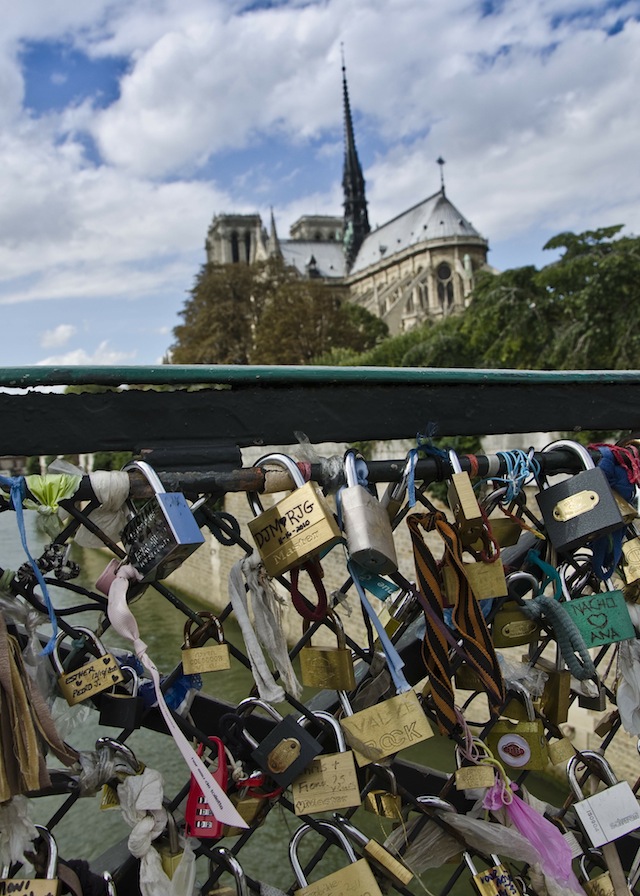
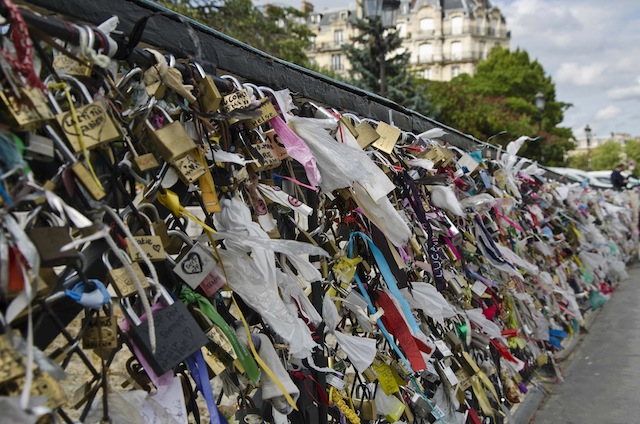
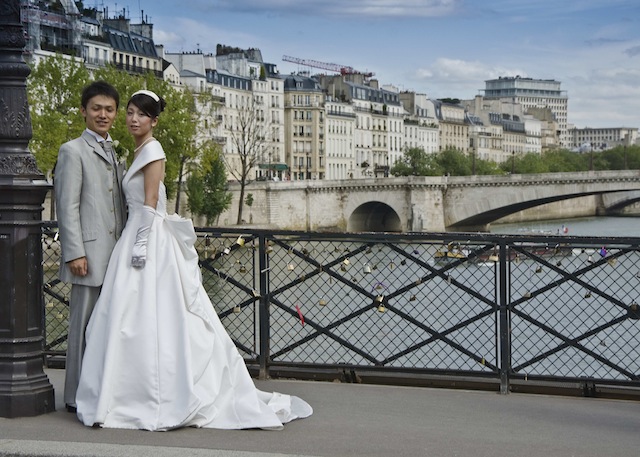
 Aphrodite,
Aphrodite,  Notre-Dame,
Notre-Dame,  bridges,
bridges,  locks,
locks,  love,
love,  rituals,
rituals,  urban legends in
urban legends in  Paris Life
Paris Life 

